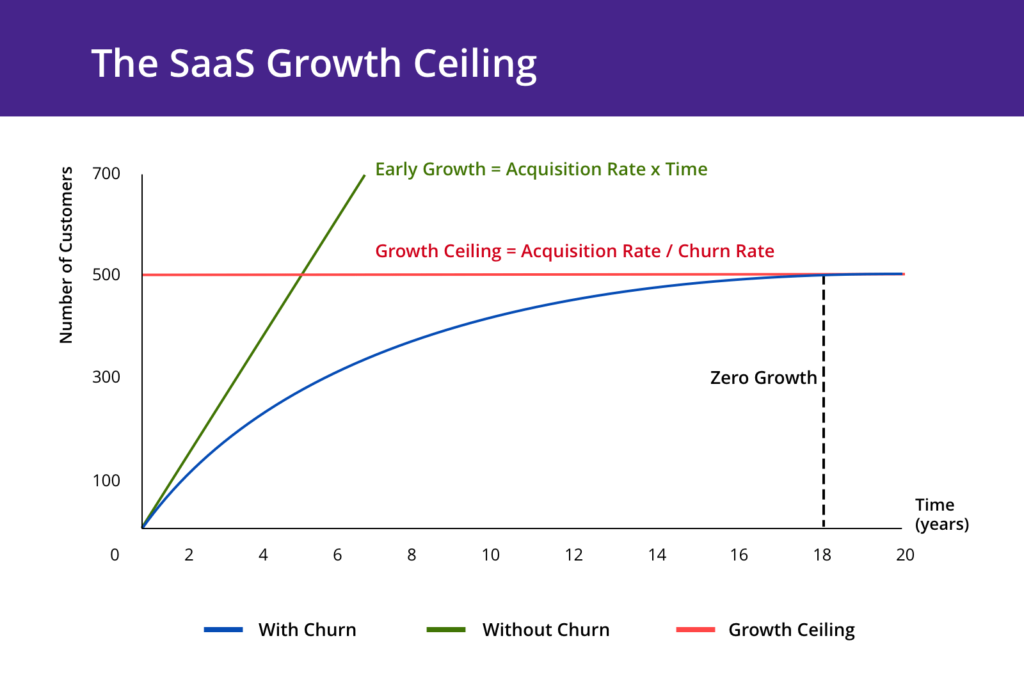What is the SaaS growth ceiling?
Many SaaS businesses overlook the multiplicative effect that churn can have on their business, especially if new customer acquisition grows linearly. Since customer churn is a percentage of the number of customers, there will come a point when the number of new customers equals the number of churned customers. At this point, the growth rate effectively stalls to zero, finding an equilibrium state known as the growth ceiling.
In this post, we’ll define the SaaS growth ceiling, show you how to calculate it, use the equation to understand the driving forces that impact the ceiling, and ultimately present three growth levers to use to avoid hitting the ceiling.
Why is the SaaS growth ceiling important?
The SaaS growth ceiling exposes the dramatic impact of churn on growth as the business scales. Understanding the growth ceiling and the dynamics behind its calculation allows you to forecast, plan, and ultimately solve these inevitable problems before this stage.
Oftentimes, early SaaS growth is rapid, but succumbs to the growth ceiling as the churned customers cancels out newly acquired customers. If you have stakes in hitting aggressive growth targets, then it’s important to understand the why and the how of this ceiling.
How to calculate your SaaS growth ceiling
The formula for calculating the SaaS growth ceiling is simple. To start, let’s define the growth ceiling as the highest recurring revenue or the most customers your SaaS business is able achieve, given a specific churn rate.
You can calculate the maximum number of customers by dividing the number of new customers by your churn rate percentage.
Max customers = customer acquisition rate / % churn rate
To get to a value for maximum revenue, you can simply multiply the maximum number of customers with your average customer lifetime value (LTV):
Max MRR = max number of customers * average revenue per account (ARPA)
It becomes easier to understand when we plot the growth ceiling on a chart, showing growth over time:

Quick example
SaaSCo. Acquires 100 new customers each year with an annual churn rate of 20%:
100 / 0.20 = 500
SaaSCo hits its growth ceiling at just 500 customers. And if the average revenue per account (ARPA) is $100:
500 * 100 = 50,000
The maximum achievable MRR for SaaSCo is just $50k.
How to smash through the SaaS growth ceiling using growth levers

The equations show us precisely which inputs and factors drive the growth ceiling. These three are, to hopefully no one’s surprise: new customer rate, lifetime value, and churn rate. Everyone’s business is different, and depending on what stage your business is in, you may be focused on a different metric.
Here are some simple guidelines to help you identify which of the three levers is the most impactful for your SaaS business.
- If your churn rate is greater than industry average (4% to 6%) then this should be the first thing you should address. Imagine churn as the bottom of your funnel. If it’s too high, then you can widen the top of your funnel all you want, but most of your customers will fall straight through. Also, due to the inversely proportional nature of churn rate to the maximum number of customers, you’ll see a higher increase in max number of customers when the churn rate lowers from 3% to 2% than if the churn rate lowers from 5% to 4%.
- Increasing the LTV of your customer base is a surefire way to grow. Note that LTV grows linearly with the max revenue ceiling. Growing LTV is doubly important because its impact can be felt throughout your entire business. Higher lifetime values will raise the customer ceiling linearly, but also increase your cash balance, decrease revenue churn, and overall boost team morale.
- Find a way to grow customer acquisition exponentially via some viral mechanism. This is the only sure fire way to beat the growth ceiling, since new customers will outpace the churn rate (which is just a percentage of the customer base). Every business is different, so it’s hard to prescribe how to find the viral growth mechanism here, but you can learn more about some common viral growth loops here.
Using the growth ceiling for positive change
Calculating your business’s growth ceiling is another way to measure and understand its growth dynamics. Knowing when and where your business will plateau will not only motivate you to act in advance, but plan accordingly to impact key metrics such as churn or LTV. Often, the actions set in motion will not produce results overnight, but will take a long time before you can see a noticeable difference in your growth.
Think of it as a countdown timer, to spur you on each day towards more sustainable growth.
